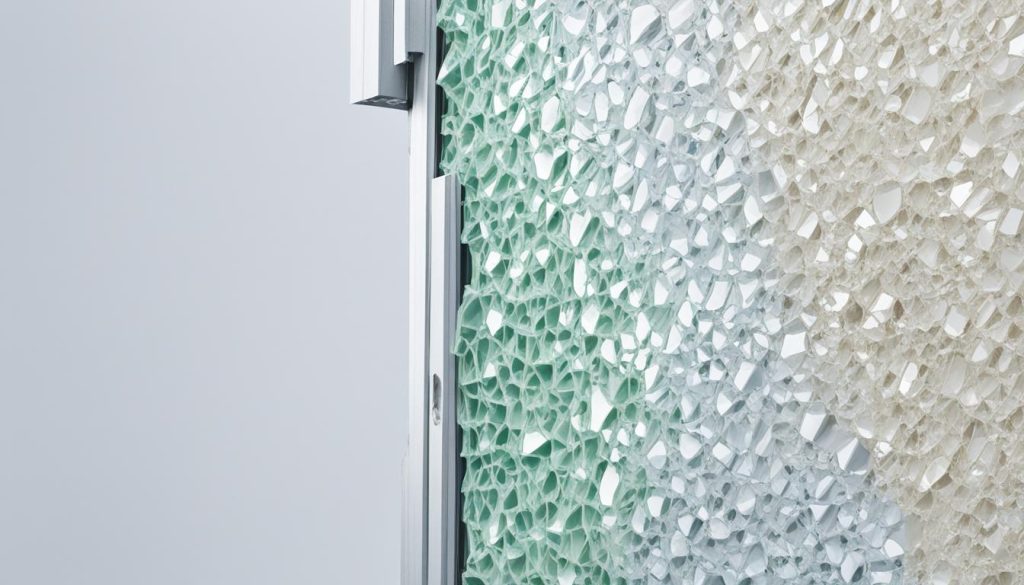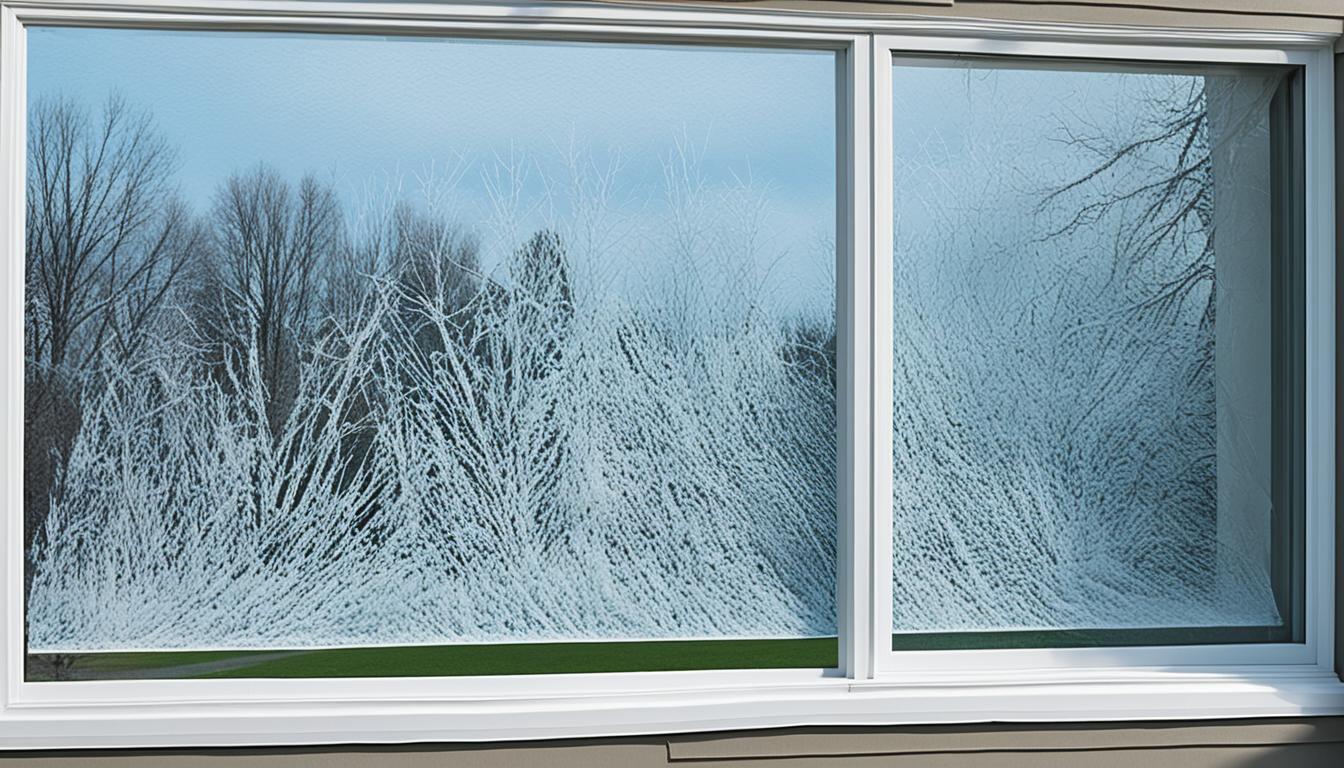Did you know that the type of window frame material you choose can have a significant impact on the energy efficiency and durability of your windows?
When it comes to window frame materials, two popular options are Fibrex and vinyl. These materials offer different benefits and considerations, making the decision process for choosing the best window material for your home particularly important.
In this article, I will compare Fibrex and vinyl, highlighting their composition, properties, and pros and cons. By the end, you’ll be equipped with the knowledge to make an informed decision for your home’s windows.
Key Takeaways:
- Fibrex and vinyl are two popular window frame materials with distinct properties and benefits.
- Fibrex is a composite material composed of 40% recycled wood fibers and 60% PVC, while vinyl is made of 100% PVC.
- Fibrex offers superior insulating properties, a higher heat distortion point, a lower thermal expansion rate, and better compressive strength compared to vinyl.
- Fibrex is considered more eco-friendly due to its use of recycled materials.
- Factors such as durability, energy efficiency, and cost should be considered when choosing between Fibrex and vinyl windows.
Composition and Properties of Fibrex Windows
Fibrex windows are crafted from a unique composite material that combines 40% recycled wood fibers with 60% PVC. This composition gives Fibrex windows a distinct set of properties that set them apart from other window frame materials.
One of the key advantages of Fibrex windows is their superior insulating properties. Compared to aluminum windows, Fibrex windows block thermal transfers at a higher rate, helping to maintain a comfortable indoor temperature and reduce energy consumption.
Another notable property of Fibrex windows is their high heat distortion point. Fibrex can withstand temperatures of up to 173°F, which is higher than the heat distortion point of vinyl windows, which typically ranges around 163°F. This means that Fibrex windows are less susceptible to warping or distortion in high heat conditions.
Fibrex windows also exhibit a lower thermal expansion rate compared to vinyl. With a thermal expansion rate of 1.6, Fibrex expands and contracts less than vinyl, which has a thermal expansion rate of 4.0. This property contributes to the overall durability and stability of Fibrex windows.
Additionally, Fibrex windows offer superior compressive strength compared to vinyl. This means that Fibrex frames can be designed to be slimmer, allowing for more glass area and maximizing natural light in your living space.
Furthermore, the composition of Fibrex windows, which includes 40% recycled wood fibers, makes them an eco-friendly choice. By utilizing recycled materials, Fibrex windows contribute to sustainable practices and the preservation of natural resources.
| Property | Fibrex Windows | Vinyl Windows |
|---|---|---|
| Insulating Properties | Superior | Standard |
| Heat Distortion Point | 173°F | 163°F |
| Thermal Expansion Rate | 1.6 | 4.0 |
| Compressive Strength | Better | Standard |
| Eco-friendliness | Utilizes recycled wood fibers | N/A |
Comparison of Fibrex and Vinyl Windows
When comparing Fibrex and vinyl windows, it becomes evident that Fibrex excels in terms of strength, durability, and overall performance. Let’s take a closer look at why Fibrex is the superior choice.
Strength and Durability
Fibrex windows are twice as strong as vinyl windows, offering exceptional resistance against chipping, warping, and rotting. This higher level of durability ensures that Fibrex windows maintain their structural integrity and aesthetic appeal over the long term.
Decay Resistance
Fibrex’s unique composition, which includes recycled wood fibers, provides natural decay resistance. This means that Fibrex windows are less susceptible to decay caused by moisture, humidity, and insects, further enhancing their longevity and performance.
Heat Distortion Point
One of the key advantages of Fibrex windows is their ability to withstand higher temperatures without warping or distorting. With a higher heat distortion point compared to vinyl, Fibrex windows offer greater thermal stability, ensuring they retain their shape and functionality even in hot climates.
Thermal Expansion
Fibrex’s lower thermal expansion rate minimizes the risk of warping and cracking. This feature is particularly important in regions with extreme temperature fluctuations, as it helps maintain a proper seal and prevents air leakage, ensuring energy efficiency and reducing heating and cooling costs.
Insulating Properties
Fibrex windows have superior insulating properties, blocking thermal transfers at a higher rate compared to vinyl windows. This means that Fibrex windows keep warm air in during winter and hot air out during summer, providing better energy efficiency and overall comfort for your home.
Compressive Strength
Another advantage of Fibrex windows is their greater compressive strength. This allows for slimmer window frames and larger glass panes, maximizing the amount of natural light entering your home while maintaining structural integrity and enhancing the aesthetic appeal of your windows.
Green Benefits
In addition to its exceptional performance, Fibrex is a more eco-friendly choice. With its composition that includes 40% recycled wood fibers, Fibrex contributes to reducing waste and utilizing sustainable materials. By choosing Fibrex windows, you can enjoy the benefits of green living without compromising on quality or durability.
| Comparison Factors | Fibrex Windows | Vinyl Windows |
|---|---|---|
| Strength | Twice as strong, providing better resistance to chipping, warping, and rotting | Less durable, more prone to chipping, warping, and rotting |
| Decay Resistance | Naturally decay-resistant, ensuring long-lasting performance | Susceptible to decay caused by moisture and insects |
| Heat Distortion Point | Higher heat distortion point, remains stable at higher temperatures | Lower heat distortion point, may warp in high heat |
| Thermal Expansion | Lower thermal expansion rate, minimizing the risk of warping and cracking | Higher thermal expansion rate, more prone to warping and cracking |
| Insulating Properties | Superior insulating properties, blocking thermal transfers at a higher rate | Less effective at blocking thermal transfers |
| Compressive Strength | Greater compressive strength, allowing for slimmer frames and more glass | Less compressive strength, limited to smaller glass panes |
| Green Benefits | Contains 40% recycled wood fibers, contributing to sustainability | Not as environmentally friendly |

Pros and Cons of Fibrex Windows
When it comes to choosing the right windows for your home, Fibrex windows offer several advantages worth considering. Let’s take a closer look at the pros and cons of Fibrex windows to help you make an informed decision.
Pros of Fibrex Windows
- Environmental Benefits: Fibrex windows are environmentally friendly as they incorporate 40% recycled wood fibers, reducing waste and promoting sustainability.
- Energy Efficiency: Fibrex windows excel at blocking thermal transfers, helping to maintain a consistent indoor temperature and saving energy by reducing the need for heating and cooling.
- Durability: With resistance to chipping and rotting, Fibrex windows offer long-lasting performance, ensuring that your investment will provide years of reliable service.
- Lifespan: Fibrex windows have a lifespan of at least 35 years, making them a durable and cost-effective choice for your home.
Cons of Fibrex Windows
- Cost: While Fibrex windows offer numerous benefits, they can be more expensive than vinyl windows, both in terms of material and installation costs.
- Distribution: Fibrex windows are exclusive to Andersen, which may limit your options for purchasing and finding local distributors.
- Installation: The installation of Fibrex windows may require higher costs compared to vinyl, depending on the complexity of the project and the specific requirements of your home.
Considering the pros and cons of Fibrex windows will help you determine if they are the ideal choice for your home. Whether it’s the environmental benefits, energy efficiency, durability, or cost, careful evaluation will ensure you make an informed decision that meets your unique needs and preferences.

Pros and Cons of Vinyl Windows
When it comes to choosing windows for your home, vinyl windows offer their own set of advantages and disadvantages. One of the major benefits of vinyl windows is their cost-effectiveness. They are an affordable option both in terms of material and installation costs, making them a popular choice for budget-conscious homeowners. Additionally, vinyl windows have a lifespan of around 20 years, providing long-term value for your investment.
Durability is another key advantage of vinyl windows. They are engineered to withstand the harsh elements, including extreme temperatures and moisture, without deteriorating. Vinyl windows are also known for their low maintenance requirements, as they do not require regular painting or staining like some other window materials. This makes them a convenient choice for homeowners who prefer easy upkeep.
However, it’s important to consider the potential drawbacks of vinyl windows. Over time, they may be susceptible to wear and tear, especially in regions with extreme weather conditions. This can manifest in issues such as warping, rotting, or peeling. Additionally, vinyl windows generally have less glass compared to other materials like Fibrex, as they are not as strong and may not be able to support larger panes. Furthermore, while installation costs for vinyl windows may be lower compared to other options, their lifespan may require more frequent replacements in the long run.
In conclusion, vinyl windows offer affordability, durability, and low maintenance. However, it’s essential to weigh the potential wear and tear, limited glass options, and the need for periodic replacements when considering vinyl windows for your home. By carefully evaluating these factors, you can make an informed decision that suits your needs, budget, and preferences.
